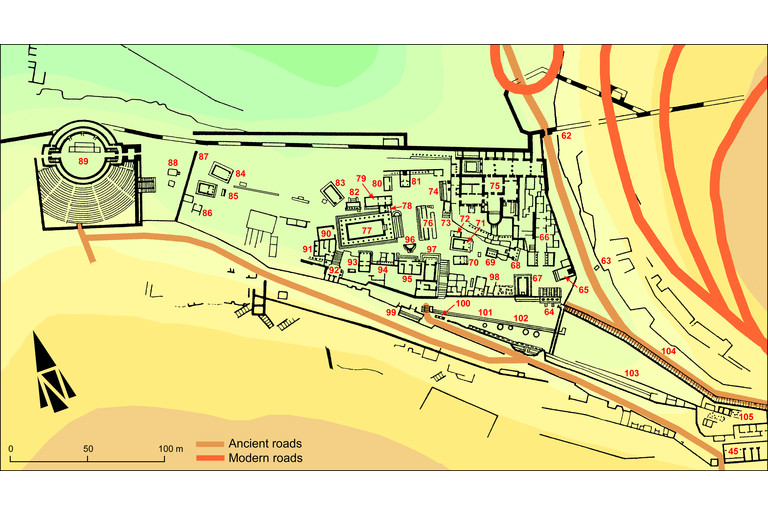Dedication to Apollo
IGCyr080500
Trismegistos ID: 738380
Source Description
Support
Low limestone wall with coping head-blocks and, below, on its Northern side, a bench for visitors (width 1.38 to 1.80 for each block).
Layout
One letter inscribed on the Northern side of each head-block; six non inscribed blocks at the right end and probably six also, now missing, at the left end, now hidden under a water channel of Byzantine date.
Letters
0.1; slight serifs, mu and sigma with four slantering strokes, open omega, epsilon with shorter middle bar.
Place of Origin
Findspot.
Date
Around the middle of the fourth century B.C. (lettering)
Findspot
Cleared in 1930 by G. Oliverio at Cyrene pleiades; HGL : Sanctuary of Apollo , Fountain Terrace , Bench of Elaiitas .
Last recorded Location
Seen by C. Dobias-Lalou in 1977 and often again in situ.
Text constituted from
Transcription from stone (CDL).
Bibliography
Stucchi, 1975 Stucchi, S., 1975, Architettura cirenaica, Monografie di Archeologia libica9, Roma - see in bibliography , p. 113, n. 6, and Laronde, 1987 Laronde, A., 1987, Cyrène et la Libye hellénistique. Libykai historiai de l’époque républicaine au principat d’Auguste, Paris - see in bibliography , pp. 189-190, whence SEG Supplementum Epigraphicum Graecum, Leiden, then Amsterdam, 1923-1971, then 1979- - see in bibliography , 38.1897. Cf. Ensoli Vittozzi, 1996 Ensoli Vittozzi, S., 1996, I rifornimenti idrici del Santuario cireneo di Apollo dal IV sec. a.C. alla fine dell'età tolemaica, in L. Bacchielli, M. Bonanno Aravantinos (eds.), Scritti di Antichità in memoria di Sandro Stucchi, I, Studi Miscellanei29, Roma, 79-110 - see in bibliography , p. 94; Ensoli, 1997 Ensoli, S., 1997, Greek Propylaea and adjacent monuments, Libya Antiqua (LibAnt)n.s. 3, 235-236 - see in bibliography .
Apparatus
1 Stucchi, 1975 Stucchi, S., 1975, Architettura cirenaica, Monografie di Archeologia libica9, Roma - see in bibliography Ἐ[λ]αιίτας [Θευδώρ]ω
French translation
Elaiitas fils de [---] os durant sa prêtrise a consacré à Apollon.
English translation
Elaiitas son of [---] os being priest dedicated to Apollo.
Italian translation
Elaiitas figlio di [---] os ha dedicato ad Apollo quando era sacerdote.
Commentary
Stucchi's restoration for the father's name was based on IGCyr096700, which is clearly much later. We follow Laronde's dating and consider the two Elaiitas to be different persons of different times. Hence a date for the wall-bench that should be older that usually proposed.
Laronde mentioned also a possible restoration of the name as Ἐπαρίτας; this was due to a former stage of his work that he did not cancel in his publication, but rejected firmly in further oral discussion and in his unpublished prosopography, inasmuch as IGCyr102000 offers another example of the rare name Ἐλαιίτας.
By the time of the discovery, Oliverio thought this wall to be a dam protecting the sanctuary from rain-water (see for example Luni, 2014 Luni, M., 2014, Attività di Carlo Anti, Luigi Pernier e Gaspare Oliverio (1923-1938), in M. Luni (ed.), La scoperta di Cirene. Un secolo di scavi, 1913-2013, Monografie di archeologia libica37, Cirene Atene d'Africa8, Roma, 123-156 - see in bibliography , p. 133). Laronde gave arguments against this idea and Ensoli Vittozzi, 1996 Ensoli Vittozzi, S., 1996, I rifornimenti idrici del Santuario cireneo di Apollo dal IV sec. a.C. alla fine dell'età tolemaica, in L. Bacchielli, M. Bonanno Aravantinos (eds.), Scritti di Antichità in memoria di Sandro Stucchi, I, Studi Miscellanei29, Roma, 79-110 - see in bibliography , p. 94 (cf. Ensoli, 1997 Ensoli, S., 1997, Greek Propylaea and adjacent monuments, Libya Antiqua (LibAnt)n.s. 3, 235-236 - see in bibliography ), following Stucchi, considered it as a bench for visitors.
Creative Commons Attributions-NonCommercial 4.0 International License.
All citation, reuse or distribution of this work must contain a link back to DOI: http://doi.org/10.6092/UNIBO/IGCYRGVCYR and the filename (IGCyr000000 or GVCyr000), as well as the year of consultation.
